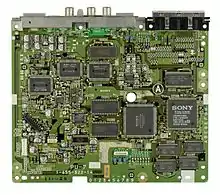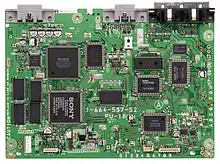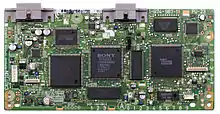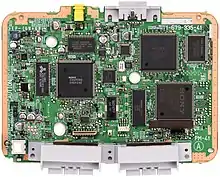
An SCPH-1000 motherboard

An SCPH-5001 motherboard

An SCPH-9001 motherboard

An SCPH-101 motherboard
The PlayStation technical specifications describe the various components of the original PlayStation video game console.
Central processing unit (CPU)
LSI CoreWare CW33300-based core[1]
- MIPS R3000A-compatible 32-bit RISC CPU MIPS R3051 with 5 KB L1 cache, running at 33.8688 MHz.[2]
- The microprocessor was manufactured by LSI Logic Corp. with technology licensed from SGI.
- Features:
- CPU cache RAM:
- 4 KB instruction cache[2]
- 1 KB data cache configured as a scratchpad[6]
Geometry Transformation Engine (GTE)
- Coprocessor that resides inside the main CPU processor, giving it additional vector math instructions used for 3D graphics, lighting, geometry, polygon and coordinate transformations – GTE performs high-speed matrix multiplications.
- Operating performance: 66 MIPS[5]
- Polygons per second (rendered in hardware):
Motion Decoder (MDEC)
- Also residing within the main CPU, enables full screen, high quality FMV playback and is responsible for decompressing images and video into VRAM.[4]
- Operating performance: 80 MIPS[9]
- Documented device mode is to read three RLE-encoded 16×16 macroblocks, run IDCT and assemble a single 16×16 RGB macroblock.
- Output data may be transferred directly to GPU via DMA.
- It is possible to overwrite IDCT matrix and some additional parameters, however MDEC internal instruction set was never documented.
- It is directly connected to a CPU bus.
System Control Coprocessor (Cop0)
- This unit is part of the CPU. Has 16 32-bit control registers.
- Modified from the original R3000A cop0 architecture, with the addition of a few registers and functions.
- Controls memory management through virtual memory technique, system interrupts, exception handling, and breakpoints.
Memory
Graphics processing unit (GPU)
32-bit Sony GPU (designed by Toshiba)[10]
- Handles display of graphics, control of framebuffer, and drawing of polygons and textures
- Handles 2D graphics processing, in a similar manner to the 3D engine
- RAM:
- Features:
- Adjustable framebuffer (1024×512)
- Emulation of simultaneous backgrounds (to simulate parallax scrolling)
- Mask bit
- Texture window
- Dithering
- Clipping
- Alpha blending (4 per-texel alpha blending modes)
- Fog
- Framebuffer effects
- Transparency effects
- Render to texture
- Offscreen rendering
- Multipass rendering
- Flat or Gouraud shading and texture mapping[2]
- No line restriction
- Colored light sourcing
- Resolutions:
- Progressive: 256×224 to 640×240 pixels[2]
- Interlaced: 256×448 to 640×480 pixels
- Colors:
- Maximum color depth of 16,777,216 colors (24-bit true color)
- 57,344 (256×224) to 153,600 (640×240) colors on screen
- Unlimited color lookup tables (CLUTs)
- 32 levels of transparency
- All calculations are performed to 24 bit accuracy
- Texture mapping color mode:[9]
- Mode 4: 4-bit CLUT (16 colors)
- Mode 8: 8-bit CLUT (256 colors)
- Mode 15: 15-bit direct (32,768 colors)
- Mode 24: 24-bit (16,777,216 colors)
- Sprite engine
- Special sprite effects:[9]
- Rotation
- Scaling up/down
- Warping
- Transparency
- Fading
- Priority
- Vertical and horizontal line scroll
Sound processing unit (SPU)
16-bit Sony SPU[4]
I/O system and connectivity
CD-ROM drive
- 660 MB maximum storage capacity, double speed (CLV) CD-ROM drive
- 2×, with a maximum data throughput of 300 KB/s (double speed), 150 KB/s (normal)[9]
- 32 KB data buffer[12]
- XA Mode 2 compliant
- Audio CD play[9]
- CD-DA (CD-Digital Audio)
- Rated for 70,000 seek operations[13]
Two control pads via connectors[9]
- Expandable with multitap connector[9]
Backup flash RAM support
- Two removable cards[9]
- Each card has 128 KB flash memory
- OS support for File Save, Retrieve and Remove[9]
- Some games (like "Music 2000") can use Memory Cards as main RAM, to store data for real time processing, bypassing the 2MB RAM limit.
Video and audio connectivity
- AV Multi Out (Composite video, S-Video, RGBS)
- RCA Composite video and Stereo out (SCPH-100x to 5000 only)
- RFU (SCPH-112X) DC out (SCPH-100x to 5000 only)
- S-Video out (SCPH-1000 only)
Serial and parallel ports
- Serial I/O (used for PlayStation Link Cable SCPH-100x to 900x only)
- Parallel I/O (N/A) SCPH-100x to 750x only)
Power input
- 100 V AC (NTSC-J); 120 V AC (NTSC-U/C); or 220–240 V AC (PAL)
- 7.5 V DC 2 A (PSone only)
See also
References
- ↑ "FastForward Sony Taps LSI Logic for PlayStation Video Game CPU Chip".
- 1 2 3 4 5 "Sony's PlayStation Debuts in Japan!". Electronic Gaming Monthly. No. 65. Sendai Publishing. December 1994. p. 70.
- ↑ "FastForward Sony Taps LSI Logic for PlayStation Video Game CPU Chip". FastForward. Retrieved 29 January 2014.
- 1 2 3 4 5 6 7 8 "Inside the PlayStation". Next Generation. No. 6. Imagine Media. June 1995. p. 51.
- 1 2 "Tech Specs: Sony PlayStation". Next Generation. No. 12. Imagine Media. December 1995. p. 40.
- ↑ Net Yaroze User Guide. Sony Computer Entertainment Inc. February 1997. p. 14.
- ↑ Karl Hodge. "Hall of Fame: Sony PlayStation, the games console that changed everything".
- ↑ "Sony PlayStation". GamePro. No. 72. IDG. September 1994. p. 20.
- 1 2 3 4 5 6 7 8 9 10 11 12 "Sony PlayStation". Next Generation. No. 24. Imagine Media. December 1996. p. 50.
- ↑ "Is it Time to Rename the GPU? | IEEE Computer Society".
- ↑ "NEXT Generation Issue #1 January 1995". January 1995.
- ↑ "Nocash PSXSPX Playstation Specifications - CDROM - Response/Data Queueing".
- ↑ "Making Crash Bandicoot – part 5". 6 February 2011.
External links
This article is issued from Wikipedia. The text is licensed under Creative Commons - Attribution - Sharealike. Additional terms may apply for the media files.